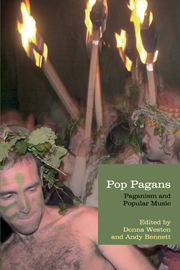Book contents
6 - The darker shade of Pagan: the emergence of Goth
from Part II - Genres
Summary
The late 1970s and early 1980s spawned an insular and self-consciously Pagan folk music scene, centred around festivals and conventions, but that wasn't the only expression of a modern Pagan music to emerge. “Goth”; a unique musical subculture that developed during the post-punk era in Britain, provided a parallel creative environment.
Following the punk rock explosion of the late 1970s, Gothic music presented a romantic, decadent and inward-looking alternative to anger and nihilism; Byronic moods largely replaced political posturing (Reynolds 2006), and black became the clothing colour of choice (Hodkinson 2002). Goth subculture in both fashion and art appropriated religious iconography from a variety of sources – Catholic, Anglican, Buddhist, Pagan and occult, but there were “no established norms for the interpretation of such signifiers” (Powell 2007: 361). Due to this broadly secular tolerance, many modern Pagan and occult practitioners found a comfortable sanctuary within Goth. According to a survey conducted by Nancy Kilpatrick for her book The Goth Bible (2004), up to 33 per cent of respondents who self-identified as Goths held allegiance to some form of Pagan belief system – by far the largest theistic grouping within Goth.
The convergence of contemporary Pagan religions and the Goth subculture is not surprising. Goth's inherent romanticism valued “medieval superstitions and primordial longings” (Reynolds 2006), while religions like Wicca promised a link to a pre-Christian past hidden within Britain's folklore (Hutton 1999). Prominent British Wiccans like Alex Sanders and cult films like The Wicker Man (1973) previously had forged a connection between Pagan religion and folk music (R. Young 2010), and by the 1990s links between adherents to Pagan faiths and the Goth subculture would be strong enough to warrant regular mention in a seminal resource guide (Mercer 1997).
- Type
- Chapter
- Information
- Pop PagansPaganism and Popular Music, pp. 76 - 90Publisher: Acumen PublishingPrint publication year: 2013



